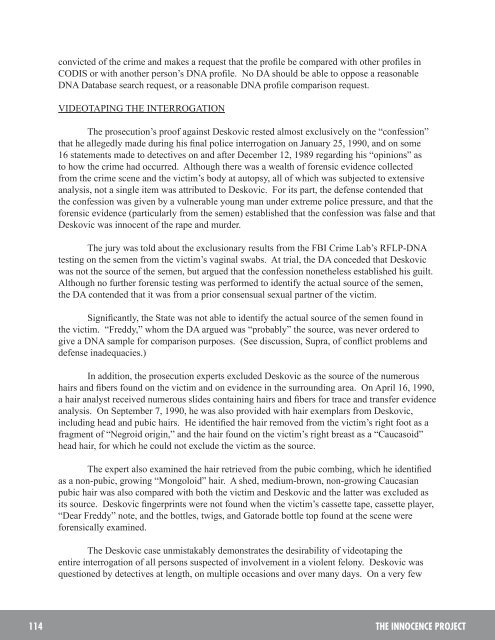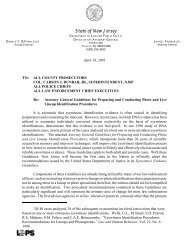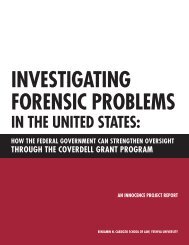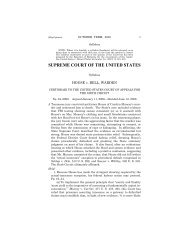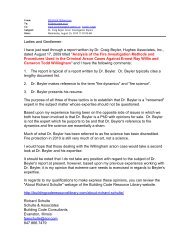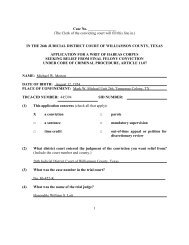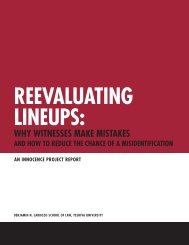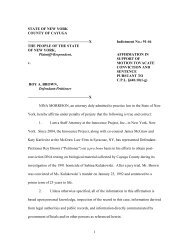Lessons Not Learned - The Innocence Project
Lessons Not Learned - The Innocence Project
Lessons Not Learned - The Innocence Project
Create successful ePaper yourself
Turn your PDF publications into a flip-book with our unique Google optimized e-Paper software.
convicted of the crime and makes a request that the profile be compared with other profiles in<br />
CODIS or with another person’s DNA profile. No DA should be able to oppose a reasonable<br />
DNA Database search request, or a reasonable DNA profile comparison request.<br />
VIDEOTAPING THE INTERROGATION<br />
<strong>The</strong> prosecution’s proof against Deskovic rested almost exclusively on the “confession”<br />
that he allegedly made during his final police interrogation on January 25, 1990, and on some<br />
16 statements made to detectives on and after December 12, 1989 regarding his “opinions” as<br />
to how the crime had occurred. Although there was a wealth of forensic evidence collected<br />
from the crime scene and the victim’s body at autopsy, all of which was subjected to extensive<br />
analysis, not a single item was attributed to Deskovic. For its part, the defense contended that<br />
the confession was given by a vulnerable young man under extreme police pressure, and that the<br />
forensic evidence (particularly from the semen) established that the confession was false and that<br />
Deskovic was innocent of the rape and murder.<br />
<strong>The</strong> jury was told about the exclusionary results from the FBI Crime Lab’s RFLP-DNA<br />
testing on the semen from the victim’s vaginal swabs. At trial, the DA conceded that Deskovic<br />
was not the source of the semen, but argued that the confession nonetheless established his guilt.<br />
Although no further forensic testing was performed to identify the actual source of the semen,<br />
the DA contended that it was from a prior consensual sexual partner of the victim.<br />
Significantly, the State was not able to identify the actual source of the semen found in<br />
the victim. “Freddy,” whom the DA argued was “probably” the source, was never ordered to<br />
give a DNA sample for comparison purposes. (See discussion, Supra, of conflict problems and<br />
defense inadequacies.)<br />
In addition, the prosecution experts excluded Deskovic as the source of the numerous<br />
hairs and fibers found on the victim and on evidence in the surrounding area. On April 16, 1990,<br />
a hair analyst received numerous slides containing hairs and fibers for trace and transfer evidence<br />
analysis. On September 7, 1990, he was also provided with hair exemplars from Deskovic,<br />
including head and pubic hairs. He identified the hair removed from the victim’s right foot as a<br />
fragment of “Negroid origin,” and the hair found on the victim’s right breast as a “Caucasoid”<br />
head hair, for which he could not exclude the victim as the source.<br />
<strong>The</strong> expert also examined the hair retrieved from the pubic combing, which he identified<br />
as a non-pubic, growing “Mongoloid” hair. A shed, medium-brown, non-growing Caucasian<br />
pubic hair was also compared with both the victim and Deskovic and the latter was excluded as<br />
its source. Deskovic fingerprints were not found when the victim’s cassette tape, cassette player,<br />
“Dear Freddy” note, and the bottles, twigs, and Gatorade bottle top found at the scene were<br />
forensically examined.<br />
<strong>The</strong> Deskovic case unmistakably demonstrates the desirability of videotaping the<br />
entire interrogation of all persons suspected of involvement in a violent felony. Deskovic was<br />
questioned by detectives at length, on multiple occasions and over many days. On a very few<br />
114 THe InnoCenCe PRoJeCT


